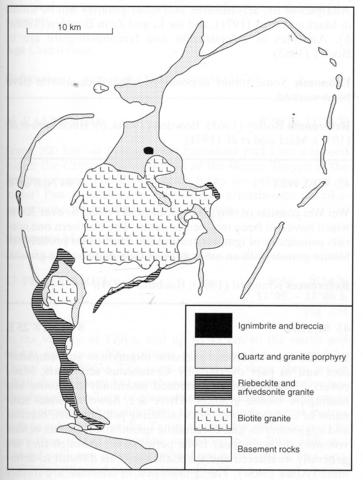stripes
The Ropp complex has a somewhat irregular, elongated triangular shape and has extensive, but outlying, arcuate and polygonal ring-dykes. The complete complex extends over 180 km2 but two thirds of this is underlain by basement rocks within the ring-dykes. The central granitic areas form rugged hills rising to more than 300 m from which a radial drainage pattern has dispersed cassiterite-bearing alluvial gravels. The earliest rocks are extrusive, confined to the northern part of the complex, and not extensive. They comprise rhyolitic explosion and intrusive breccias, net-veined granites, and quartz porphyries. A generally later plutonic cycle becomes progressively more alkaline through a series of biotite and hornblende-biotite granites, before three riebeckite granites were intruded which were followed by pyroxene-fayalite granite and then a final biotite granite. Black (Buchanan et al., 1971) mapped 11 principal granites. The main outcrops of riebeckite-bearing granite are concentrated along an apophysis that extends southwards from the main complex and which comprises part of the ring-dyke system. The earliest such granite forms the western margin of the apophysis and consists of microcline perthite, riebeckite, biotite, locally astrophyllite, occasional pyrochlore and accessory fluorite and zircon. In one area the sole mafic mineral is aegirine and Black (Buchanan et al., 1971) considers that this could be a separate intrusion. A later, and more extensive, riebeckite-biotite granite also builds the southerly apophysis but is also found along many of the fractures forming the ring-dyke system. The rock is variably feldspar- and quartz-phyric. The third, and least voluminous, peralkaline granite is situated on the eastern margin of the central complex. The rock is fine-grained with streaks and eddies of acicular riebeckite crystals, most of which have cores of aegirine. Pyrochlore is abundant and thomsenolite is a major constituent. An analysis indicates a fluorine content of 1.69% (MacLeod et al., 1971). This rock is described in some detail by Beer (1952). The following granite, which is the most extensive in the complex, forms the principal part of the polygonal ring-dyke system and extends for more than 40 km. The dyke varies in width from 30 to 300 m and is petrographically varied with facies being equigranular or porphyritic. The mafic minerals are commonly biotite and hornblende but in one area the rock is a hedenbergite-fayalite granite. Igneous activity closed with a suite of dolerite dykes. Data on the Zr content of the granites are given by Bowden (1966b).
BEER, K.E. 1952. The petrography of some of the riebeckite-granites of Nigeria. Report, Geological Survey and Museum, Atomic Energy Division, U.K., 1-38.BOWDEN, P. 1966b. Zirconium in Younger granites of northern Nigeria. Geochimica et Cosmochimica Acta, 30: 985-93.BUCHANAN, M.S., MACLEOD, W.N., TURNER, D.C., BERRIDGE, N.G. and BLACK, R. 1971. The geology of the Jos Plateau. Volume 2, Younger granite complexes. Bulletin, Geological Survey of Nigeria, 32: 1-159.MACLEOD, W.N., TURNER, D.C. and WRIGHT, E.P. 1971. The geology of the Jos Plateau. Volume 1, General geology. Bulletin, Geological Survey of Nigeria, 32: 1-110.

